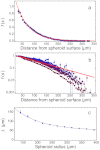Interplay between distribution of live cells and growth dynamics of solid tumours
- PMID: 23251776
- PMCID: PMC3524520
- DOI: 10.1038/srep00990
Interplay between distribution of live cells and growth dynamics of solid tumours
Erratum in
- Sci Rep. 2014;4:3387
Abstract
Experiments show that simple diffusion of nutrients and waste molecules is not sufficient to explain the typical multilayered structure of solid tumours, where an outer rim of proliferating cells surrounds a layer of quiescent but viable cells and a central necrotic region. These experiments challenge models of tumour growth based exclusively on diffusion. Here we propose a model of tumour growth that incorporates the volume dynamics and the distribution of cells within the viable cell rim. The model is suggested by in silico experiments and is validated using in vitro data. The results correlate with in vivo data as well, and the model can be used to support experimental and clinical oncology.
Figures





References
Publication types
MeSH terms
LinkOut - more resources
Full Text Sources

